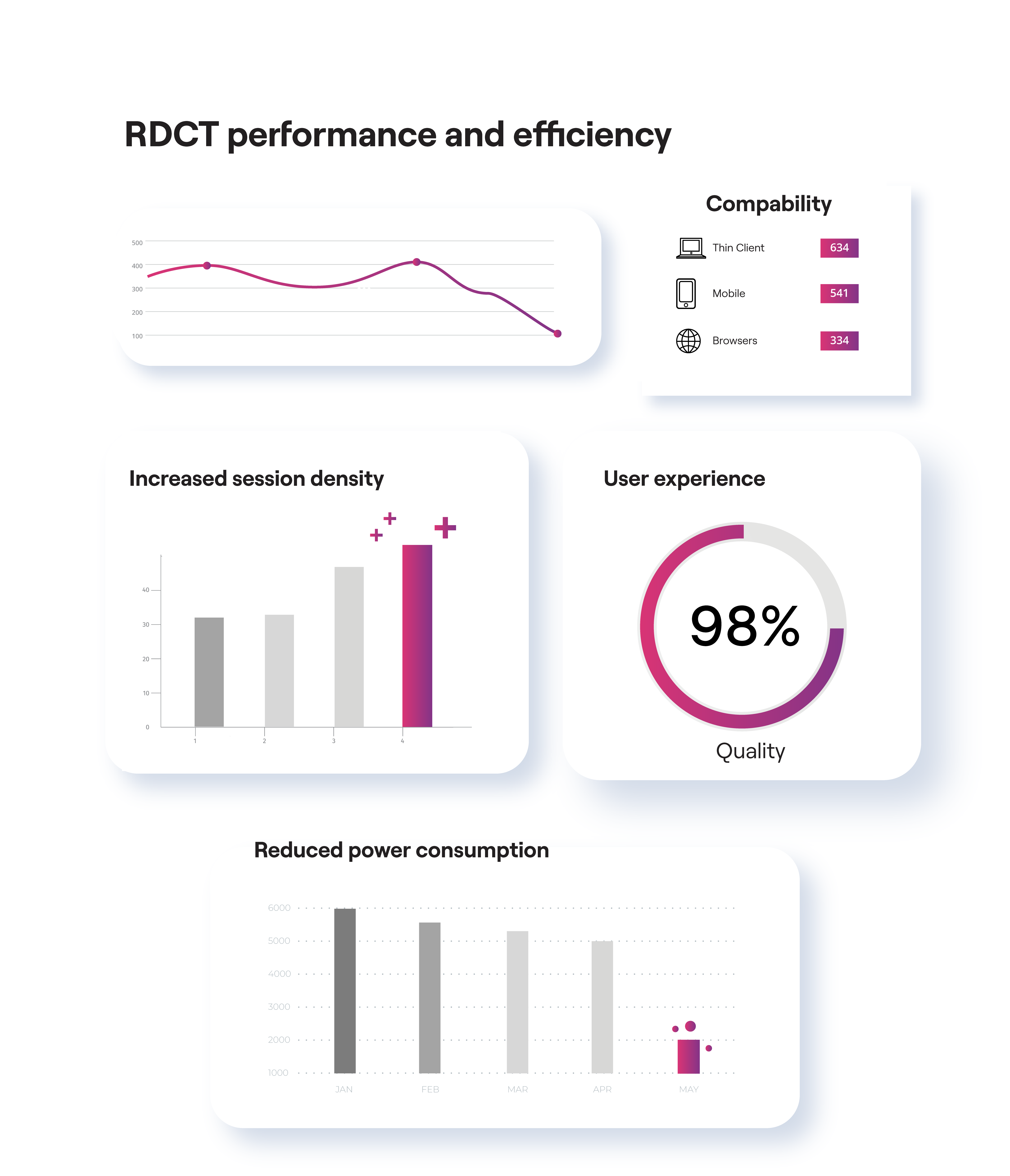
DaaS & VDI platforms must continually optimize for performance, scalability, and user experience. These platforms face increasing challenges due to high-resolution content delivery, fluctuating network conditions, and the growing demand for cost-effective scalability.
Standard video codecs often present trade-offs between visual fidelity and bandwidth consumption or processing load. These trade-offs become more pronounced at scale, directly affecting infrastructure costs, session density, and quality of service. Remote Desktop Coding Tools (RDCT), a hybrid solution based on H.264 enhanced with MPEG-5 LCEVC and desktop domain coding optimizations (including desktop content entropy tuning, region-of-interest coding, and improved color management), would offer a flexible and integrable response to these challenges.
The use of RDCT across the DaaS and VDI value chain would enable vendors and integrators to meet enterprise demands for performance, reliability, and cost-efficiency without requiring significant infrastructure overhauls.
RDCT in DaaS & VDI value chain
RDCT would add value at multiple stages of the DaaS & VDI value chain:
Managed workspace layer (DaaS & VDI provider)
The RDCT encoder would be integrated into the virtual desktop host environment. Depending on the tuning preset, High Quality (HQ) or Low Complexity (LC), it would allow administrators to optimize either image quality or encoding efficiency, depending on customers’ and business needs. This encoder would be deployable via standard virtualization frameworks or proprietary protocols.
Protocol and transport layer
Encoded video streams would be encapsulated within existing remote desktop protocols (e.g., ICA, PCoIP, Blast, RDP) with minimal overhead. RDCT’s codec design ensures backward compatibility with H.264 containers while leveraging LCEVC enhancement layers for improved compression performance. Additionally, its Unified API would simplify integration by providing a common interface across encoding and decoding components, accelerating deployment with protocols and across varied host and client systems.
Content distribution across variable network conditions
RDCT would provide superior bitrate savings, allowing DaaS & VDI sessions to adapt better to constrained or unstable network conditions, enabling your customers to access the best possible experience from any device, anywhere.
Managed workspace layer (DaaS & VDI provider)
The RDCT encoder would be integrated into the virtual desktop host environment. Depending on the tuning preset, High Quality (HQ) or Low Complexity (LC), it would allow administrators to optimize either image quality or encoding efficiency, depending on customers’ and business needs. This encoder would be deployable via standard virtualization frameworks or proprietary protocols.
Protocol and transport layer
Encoded video streams would be encapsulated within existing remote desktop protocols (e.g., ICA, PCoIP, Blast, RDP) with minimal overhead. RDCT’s codec design ensures backward compatibility with H.264 containers while leveraging LCEVC enhancement layers for improved compression performance. Additionally, its Unified API would simplify integration by providing a common interface across encoding and decoding components, accelerating deployment with protocols and across varied host and client systems.
Content distribution across variable network conditions
RDCT would provide superior bitrate savings, allowing DaaS & VDI sessions to adapt better to constrained or unstable network conditions, enabling your customers to access the best possible experience from any device, anywhere.
Endpoint layer (OS and Thin Clients)
The RDCT decoder would be integrated into endpoint software stacks, including thin clients, mobile devices, or browser-based agents. Its low-complexity design and H.264 bitstreams would allow for broad hardware support in almost any device. Integration with GStreamer would enable straightforward deployment in Linux-based environments and embedded systems, enhancing RDCT’s portability and compatibility across diverse thin client platforms. Lightweight decoding would be especially beneficial for battery-powered devices and cloud endpoints.
Presentation & application layer
End-users would benefit from consistent visual fidelity and reduced latency. Whether working within enterprise applications, browser-based tools, or industry-specific platforms (e.g., healthcare, finance), RDCT would ensure an optimal experience without requiring modifications to the software layer.
Endpoint layer (OS and Thin Clients)
The RDCT decoder would be integrated into endpoint software stacks, including thin clients, mobile devices, or browser-based agents. Its low-complexity design and H.264 bitstreams would allow for broad hardware support in almost any device. Integration with GStreamer would enable straightforward deployment in Linux-based environments and embedded systems, enhancing RDCT’s portability and compatibility across diverse thin client platforms. Lightweight decoding would be especially beneficial for battery-powered devices and cloud endpoints.
Presentation & application layer
End-users would benefit from consistent visual fidelity and reduced latency. Whether working within enterprise applications, browser-based tools, or industry-specific platforms (e.g., healthcare, finance), RDCT would ensure an optimal experience without requiring modifications to the software layer.
How RDCT would improve cost, QoE, and compliance
By integrating RDCT across the DaaS & VDI infrastructure stack, providers would realize multiple technical and business benefits:
Reduced bandwidth costs
RDCT would achieve better bitrate efficiency than standard H.264, particularly at high resolutions or frame rates.
Increased session density
The Low Complexity tuning preset would reduce server-side compute load, enabling more concurrent desktop sessions per server. Improved user experience: Enhanced visual quality at lower bitrates would result in smoother, more responsive desktop interactions.
Compatibility
RDCT would be deployable within existing infrastructure and compatible with common protocols, reducing time-to-integration.
Device agnostic playback
The decoder would support thin clients, embedded systems, and cross-platform delivery, including mobile and web.
Sustainability
Lower power usage at both ends of the chain (encoding and decoding) would contribute to energy-efficient deployments.

By integrating RDCT across the DaaS & VDI infrastructure stack, providers would realize multiple technical and business benefits:
Reduced bandwidth costs
RDCT would achieve better bitrate efficiency than standard H.264, particularly at high resolutions or frame rates.
Increased session density
The Low Complexity tuning preset would reduce server-side compute load, enabling more concurrent desktop sessions per server. Improved user experience: Enhanced visual quality at lower bitrates would result in smoother, more responsive desktop interactions.
Compatibility
RDCT would be deployable within existing infrastructure and compatible with common protocols, reducing time-to-integration.
Device agnostic playback
The decoder would support thin clients, embedded systems, and cross-platform delivery, including mobile and web.
Sustainability
Lower power usage at both ends of the chain (encoding and decoding) would contribute to energy-efficient deployments.

